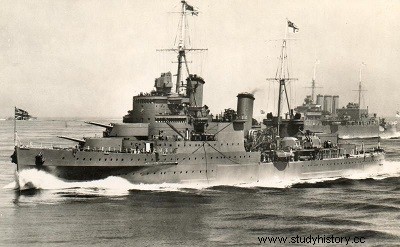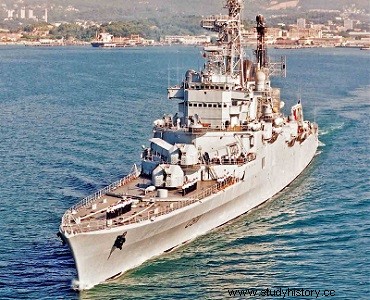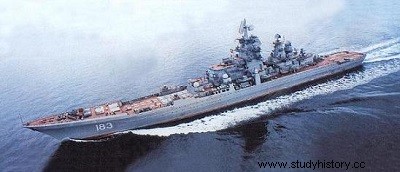
A cruiser is a warship. Since the beginning of the 1990s and the decommissioning of all battleships, it has been the most powerful and largest combat vessel, except for aircraft carriers and aircraft carriers.
Historically, it was considered a ship capable of operating individually, cruising, like a battleship, but lighter and more mobile.
The cruiser today
In modern military terminology, a cruiser (NATO code CC, CG, missile launcher, or CGN, nuclear-powered) is a large combat vessel that has the weapon systems allowing it to intervene in all areas of combat principal aspects of combat at sea:anti-submarine warfare, anti-ship warfare, anti-aircraft warfare, attacking land targets. It is larger in tonnage than a destroyer and a frigate, more specialized in combat areas.
Cruisers are generally equipped with cruise missiles (attack on land targets), anti-ship missiles, anti-aircraft missiles and carry helicopters with anti-submarine or anti-ship purposes.
Currently, only the US Navy and the Russian Navy have cruisers. The French Navy also owned until 2010 the Jeanne d'Arc, a "helicopter carrier cruiser". However, at the end of a long career, she played more the role of a school ship intended for the training of student officers of the Naval Academy than that of a modern combat ship.
The United States integrated their cruisers into the carrier battle groups (CVBG in English:Carrier Vessel Battle Group) formed around their nuclear-powered aircraft carriers, specializing them instead in a role of anti-aircraft and anti-missile protection, to which their Aegis combat system is particularly intended.
History
The term "cruiser" is an invention of the mid-19th century. In the age of the sailing navy, frigates were small, lightly armed vessels, with a battery on one deck, but capable of long cruises. They were supposed to avoid engagement with the bulk of the enemy forces thanks to their superior speed to ships of the line.
The appearance of battleships, with their armament also on a single deck, which therefore were often referred to as armored frigates, caused the change of these into cruise ships, a name which was quickly shortened to cruiser. For many years, the cruiser was the intermediate building between the battleship and the destroyer or destroyer. It therefore assumed the missions formerly devolved to the old frigates and corvettes, namely:
privateering, where the challenge was commercial navigation, where he could act in attack during raids, or in defense by escorting convoys, this type of operation will often be called cruiser warfare.
the lighting and liaisons of the fleet, when integrated into the line squadrons.
the maintenance of the presence in the distant colonies where it often served as the main battleship and symbol of sovereignty.
The cruisers thus filled one of the gaps of the battleships, which, although without rivals from the point of view of armament and protection, were not very capable of being sent far from their base, in particular because of their enormous consumption of coal.
This great diversity of tasks, associated with the technological evolution of the end of the 19th century, caused quite quickly a specialization of cruisers.
Armoured cruisers
In 1875 appeared the British Shannon, which was the first representative of armored cruisers. These combined a fairly powerful armament with generally two or four main pieces of a caliber of 203 or 254 mm and a dozen secondary pieces often of 152 mm. A protection, consisting of an armored belt of medium thickness, allowed him to undergo only the shooting of parts equivalent to those which he embarked. It could also spin at a speed slightly higher than the battleships of the time, thus escaping their hunt. Battlecruisers could be seen as second rate battleships, often intended to form overseas squadrons.
Protected cruisers
Below them, appeared around 1880, another lighter type, the protected cruiser, whose protection consisted of an armored deck covering the boilers and steam engines, as well as the ammunition compartments. They were armed with a dozen medium caliber guns, often 152 mm. Their main missions were reconnaissance and privateering.
Auxiliary cruisers
Before the end of the century, there also appeared the practice of fitting out merchant ships for privateering, or the protection of convoys. These buildings were called auxiliary cruisers and, although less armed and protected than conventional cruisers, they took a significant part in these missions, especially during the two world wars.
The converted ships were often ocean liners, chosen for their high speed, which were equipped with medium-caliber pieces allowing them to deter enemy cruisers from attacking the convoy, not by the risk of direct destruction but above all by fear. serious damage, very far from a friendly base. Another variant, often called raider, consisted in the conversion of a freighter whose armament was then concealed, allowing it to act with the effect of surprise. This technique was used mainly by Germany, sometimes with great success, as in the Kormoran affair in 1941 (battle between the Sydney and the Kormoran).
Battlecruisers
Along with the appearance of the dreadnought for battleships, the theories of British Admiral John Arbuthnot Fisher caused the appearance of a new type of ship of the line. This concentrated all its artillery in the maximum caliber to be able to destroy its opponents at the greatest possible distance. The protection was not supposed to protect the building against equivalent artillery, but only against pieces of intermediate calibers. Fisher's philosophy of this reform is contained in one of his statements, speed is protection. These new battlecruisers will therefore be very fast ships, about five knots more than contemporary battleships thanks to the weight saved on the armor which will allow them to be equipped with much more powerful turbines. Their tonnage, their dimensions as well as their artillery are identical to those of the battleships of the time, on the other hand they are unable to support the fire of these in a prolonged way. This doctrine will initially prove quite effective during, for example, the engagement of the Falklands, where the battlecruisers will show that they are the natural predators of the aging armored cruisers, but it will show its limits during the engagements of greater importance against dreadnoughts as at the Battle of Jutland. On this occasion, the British battlecruisers will suffer a real slaughter against the German battlecruisers and the German line fleet:3 of them will explode. In the French Navy, the Dunkerque (1937) and the Strasbourg (1939) will be atypical buildings sometimes classified as battleships or battle cruisers, according to historians. They are better protected but slower than a battlecruiser, but faster, with lower protection than a battleship. The appearance of fast battleships shortly before the Second World War (of which the Richelieu of the French Navy is a perfect illustration), will eventually give the final blow to the battlecruiser concept. Many people confuse cruisers, battlecruisers and battleships. Battlecruisers, like battleships, are ships of the line.
Light cruisers and heavy cruisers
Around 1895, protected cruisers began to be supplanted by a new type of ship benefiting from the contribution of new technologies, in particular with the appearance of turbines for propulsion which gave them much higher speeds. The armament benefited from the generalization of rapid-fire guns and armor, thanks to advances in metallurgy, the addition of an armored belt in addition to the protective bridge. Good examples of this new type, the light cruisers, were the British of the Town class, the French of the type La Marseillaise or the German of the Dresden type.
During the First World War, an increase in size and offensive power gave rise to a new category, the heavy cruiser, whose first representatives were the British Hawkins class, armed with 203 mm guns. However, the distinction between the two was not really codified until the Treaty of Washington, where the caliber of the artillery of light cruisers was limited to 155 mm and that of heavy cruisers to 203 mm, the displacement not having to exceed 10 000 TW for heavy cruisers.
These limits were not crossed until the approach of the Second World War, with the appearance of the German pocket battleships of the Deutschland class (which despite their name, because of their main mission, the attack of enemy commerce, should be considered cruisers) and in the Pacific Ocean, by the powerful Japanese heavy cruisers of the Chokaiou Mogami classes.
At the same time, the appearance of the major threat posed by bomber planes made certain light cruisers specialize. To combat this threat, they were equipped with a strong battery of so-called dual-use artillery pieces (against the surface and anti-aircraft). The precursors were again the British with the Dido-class light cruisers launched from 1940 and armed with eight, then ten high-rise 133 mm guns and fitted with a fire control system with radar. Heavy cruisers, on the other hand, had their peak at the end of the Second World War with the American Alaska class, armed with nine 305 mm guns and displacing 27,000 tons. This class of buildings was in fact closer to the ship of the line than to the heavy cruiser designed according to the restrictive rules of the Washington Treaty.
Missile Cruisers - The Missile Age

The prevalence of aerial danger and the emergence of a new weapon to fight against it, the anti-aircraft missile, caused after the Second World War, a profound change in the construction of cruisers. The main artillery quickly lost importance in favor of the detection and launching means of these new weapons and a strong battery of anti-aircraft guns.
The eclipse of battleships, as main surface combat vessels, although largely to the benefit of aircraft carriers, nevertheless forced cruisers to take over part of their missions, in particular when long-range anti-ship missiles litter reached maturity. Nations like the Soviet Union, based a good part of their naval power on large cruisers with a strong offensive vocation, part of which was specialized in the fight against submarines and another in the attack of carrier battle groups.

